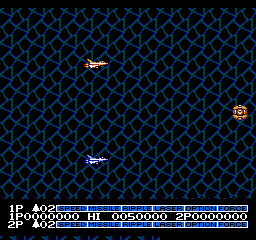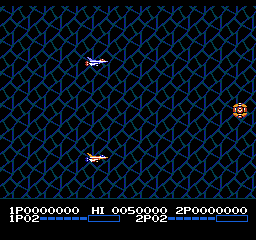Life Force (NES)
| Life Force |
|---|
|
Also known as: Salamander (JP), Life Force: Salamander (EU)
|
Life Force is a spin-off of the Gradius series. Unlike Gradius, this game has a cooperative mode: Player 1 controls Vic Viper, while Player 2 is Lord British (not to be confused with the Lord British of the Ultima series).
Contents
Sub-Page
| Prerelease Info |
Unused Graphics
Extraneous Compressed Data
Most of the graphics in this game are stored in the ROM in twelve compressed blocks, using the same RLE compression as several other Konami NES games such as Blades of Steel and Contra. In Salamander, the fourth compressed block, consisting of the tiles for the power meter, contains a large amount of extraneous junk: 2560 zero bytes (which take up very little actual space due to the RLE compression) followed by a compressed copy of the tiles for the stage 1 Golem boss (which does take up actual space). When the game decompresses this data block, the extra data ends up in the nametable section of VRAM, where it is promptly overwritten by the stage background. The stage 1 boss tiles that are actually loaded when encountering the boss are stored elsewhere in the ROM, uncompressed.
In Life Force all of the compressed data seems to have been rebuilt, and this junk data is not present.
Ripple Laser
| Unused Sprite | In-game Ripple Laser | "Fixed" Ripple Laser |
|---|---|---|
Among the shared graphics for vertical stages is an unused 8x16 sprite for the edge of a Ripple Laser. The fully-expanded Ripple Laser as it appears in-game is asymmetrical and a bit distorted, due to being awkwardly constructed using parts of the half-expanded version. By using the unused sprite, it's possible to construct a Ripple Laser that is symmetrical and that looks more like the version seen in horizontal stages. However, this "fixed" graphic takes up four 8x16 sprites despite being only 24 nontransparent pixels long. It *would* fit into three sprites if the pixels in the constituent tiles were simply shifted over four places.
It seems likely what happened is that the developers decided the Ripple Laser needed to be reduced from four sprites to three to control sprite flicker but there wasn't time to get the artist to update the sprite, so they had to make do and improvise a three-sprite version with the asset they had.
Regional Differences
- The stars in the background on stage 5 are animated in Salamander.
- In Salamander, you can get a maximum of three options. This was dropped to two for Life Force.
- In Salamander, a "blop!" sound effect plays before the Tetran boss fight. It was removed in Life Force.
- Life Force makes use of a code on the title screen, which increases the number of lives from 3 to 30, but it is not the Konami code, it's only part of it (Up, Up, Down, Down, B, A), but the program will ignore Left or Right pressings, so you could press any amount of them in any order, so the full Konami code for example will be accepted as well.
Title Screen
| Japan | US | Europe/Virtual Console |
|---|---|---|

|

|

|
The Japanese title screen is a lot more interesting than the completely static US/European version, featuring a starfield effect and animated fireball circling around the logo. Also note the "NINTEND" typo in the US version, which was fixed in the European and 3DS Virtual Console releases.
Power Meter
| Japan | US |
|---|---|

|

|
In Salamander, the Power Meter is similar to those featured in the Gradius games. The HUD is organized into three rows: Player 1's Power Meter on top, the scores in the middle, and Player 2's Power Meter on the bottom. A ship icon is also used for denoting a player's lives.
In Life Force, the Power Meter is smaller and different. There are only two rows of information, with each player's score on the top row and the Power Meters on the bottom row. The Power Meters are condensed: the six options are shown as small boxes with the current selection drawn with a box around it, and a box on the right shows the text for the current option, a layout very similar to the MSX version of the game. The ship icon is also gone. Despite all of this, the setup from Salamander is still seen in pictures for the box and manual.
Additionally, in horizontal stages the entire screen is positioned two pixels higher in Life Force than in Salamander.
Before a boss fight of some stages, the power meter will disappear. The following levels have timing differences:
| Stage | Salamander | Life Force |
|---|---|---|
| Stage 1 | When the screen scrolling stops | When the background disappears |
| Stage 2 | When the boss starts moving left | When the boss appears |
| Stage 5 | When the boss lights up | When the wall starts to collapse |
Ending
After beating the last boss, both versions show the ship escaping the planet as it explodes. Afterwards, it just shows the Konami logo in Life Force. But in Salamander, there's a staff roll with an image on the left side of the screen. This image changes depending upon how many continues were used. If 3 continues were used, the pilot's helmet is shown; if 1-2 were used, the Vic Viper is shown; if no continues were used, the pilot is shown.
STAFF PROGRAMMED BY S.UMEZAKI T.DANJYO H.HORI H.YANAGISAWA CHARACTOR DESIGN S.MURAKI Y.YOSHIMOTO C.OZAWA J.MARUO MUSIC BY S.SAKAMOTO S.TERASHIMA H.MAEZAWA A.FUJIO VISUAL DESIGN K.SHIMOIDE N.SATOH SPECIAL THANKS H.MACHIGUCHI DIRECTED BY S.UMECHAN AND OSETSUSAN PRESENTED BY KONAMI
The Gradius series
| |
|---|---|
| Arcade | Nemesis • Vulcan Venture • Gradius III • Solar Assault • Gradius IV: Fukkatsu |
| NES | Gradius • Gradius II |
| MSX | Nemesis |
| PC-88, Sharp X1 | Gradius |
| ZX Spectrum | Nemesis |
| SNES | Gradius III |
| Game Boy | Nemesis • Gradius: The Interstellar Assault |
| Sharp X68000 | Gradius • Gradius II: Gofer no Yabou |
| Sega Saturn | Gradius Deluxe Pack |
| PlayStation | Gradius Deluxe Pack |
| Game Boy Advance | Gradius Galaxies |
| PlayStation 2 | Gradius V |
| WiiWare | Gradius ReBirth |
| Salamander | |
| Arcade | Life Force |
| NES | Life Force |
Cleanup > Pages missing date references
Cleanup > Pages missing developer references
Cleanup > Pages missing publisher references
Games > Games by content > Games with regional differences
Games > Games by developer > Games developed by Konami
Games > Games by platform
Games > Games by publisher > Games published by Konami
Games > Games by release date > Games released in 1987
Games > Games by release date > Games released in September
Games > Games by release date > Games released in September > Games released on September 25
Games > Games by series > Gradius series
The Cutting Room Floor > Unimportant Awards > NES games



